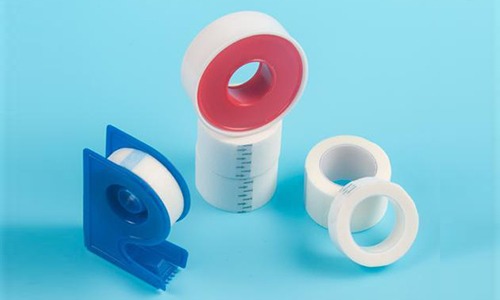
Hot melt pressure sensitive adhesives have been widely used in the medical tape and adhesive bandage market. Prior to the introduction of hot melt pressure sensitive adhesives into this application market, solvent-based and calendared natural rubber (NR)-based pressure sensitive adhesives dominated the market.
NR-based pressure sensitive adhesives typically use rosin or its derivatives to increase viscosity. Due to the high acidity or polarity of this type of pressure sensitive adhesive, it can produce good adhesion on the skin. However, these pressure sensitive adhesives with acid values also often cause sensitisation on human skin. Rosin and its derivatives have been strictly banned by many international manufacturers of leading brands of medical tape and adhesive tapes.
However, without rosin and its derivatives in the formulation of SBC-based hot-melt pressure-sensitive adhesives, it is quite difficult to adhere to the skin. With the loss of the physisorption contribution of polarity, the selection of low-polarity SBCs and synthetic hydrocarbon tackifiers that do not irritate the skin to adhere to the skin is a challenge that most Hot Melt Adhesive formulators need to face.
Hot-melt pressure-sensitive adhesive tops for medical tapes
Hot melt adhesives can be applied in a variety of ways. Regardless of the method of application, the hot melt adhesive must be pre-heated to a molten state in a melt tank and then sprayed or transferred directly onto the substrate or object to be glued using appropriate gluing equipment.
Common substrates for medical tapes are non-woven fabrics, PE films, and silk fabrics. The gluing equipment consists of two types of rollers and dies.
In order to obtain the characteristics of breathable, in addition to punching holes in the substrate, but also can choose to spot gluing wheels, or with a special die to create a hole, not full plate on the gluing surface. Although the spraying equipment can provide good air permeability, but after spraying the hot melt pressure sensitive adhesive will be rapidly cooled by the air and greatly reduce its anchor to the substrate, the adhesive force. After the finished product is made, there is often a problem of adhesive transfer to the back of the tape or adhesive residue on the skin.
Since medical tapes use different substrates and gluing equipment and methods, hot melt adhesive manufacturers usually have to provide a variety of hot melt adhesives with different workability and viscoelasticity to satisfy this diverse market. How to get the special adhesive properties and workability of hot melt pressure sensitive adhesive at the same time depends on the hot melt adhesive producer, adhesive pastes factory and users to communicate and co-operate to complete.
Typically, die mounted adhesives can accept a wide range of consistencies, from 2,000 to 20,000 cps, while roller mounted adhesives require a lower range of consistency, usually below 10,000 cps. Lower consistency hot melt adhesives are easier to apply and the processing temperature can be lowered moderately. However, the heat resistance of these hot melt adhesives is usually lower.
Properties of hot melt pressure sensitive adhesives for medical tapes
Hot melt pressure sensitive adhesives used in the medical tape market need to have appropriate coating workability and thermal stability as well as non-itching, adhesion and breathability properties.
1) Applicability As mentioned in the previous section, hot melt pressure sensitive adhesives can be applied to a variety of special substrates by special dies or rollers. However, the
However, hot melt pressure sensitive adhesives for medical tapes typically have high flow properties and can easily penetrate into porous substrates resulting in overspray.
In addition, many substrates for medical tapes are not able to withstand high heat and may be stretched, deformed, or even damaged during application. As a result of these operational problems, hot melt pressure sensitive adhesives are often applied to high heat resistant release paper and then transferred to a variety of substrates.
Products for the film market require the release paper to be retained, and the adhesive-coated composite structure is slit into rolls or cut into appropriate sheet sizes before packaging. Tape products, on the other hand, require the composite structure to be rewound once, the release paper separated, and the tape individually rewound and slit to the desired width and length.
2) Non-Itchy Usually solvent-based adhesives used in medical tapes cause skin allergies and require the addition of zinc oxide powder to the adhesive.
The function of zinc oxide powder is two-fold: firstly, to reduce the allergy of solvent-based adhesive to the skin; secondly, to enhance the moisture-absorbent or sweat-absorbent ability of the adhesive.
Proper selection of hot melt pressure sensitive adhesive composition can completely prevent skin allergy problems. From the point of view of allergenicity, hot-melt pressure-sensitive adhesives have been recognised by medical and health authorities as the most suitable adhesives for skin. In general, the addition of rosin or esterified rosin and other tackifying resins to hot-melt pressure-sensitive adhesives can greatly improve their adhesive strength to the skin and overcome the problem of adhesive loss and peeling off of the tape after perspiration. However, the high polarity (high physical adsorption) of these natural tackifying resins can cause serious skin irritation. Therefore, hot-melt pressure-sensitive adhesives for medical tapes should never contain such ingredients.
3) Adhesion Since natural tackifying resins such as rosin or esterified rosin are not suitable for medical adhesive tapes, the softness and wettability of the hot-melt pressure-sensitive adhesive itself, the so-called viscoelasticity, must be used to obtain adhesion to the skin.
 HOT LINE: 086-577-65159218
HOT LINE: 086-577-65159218












